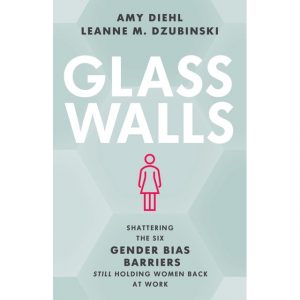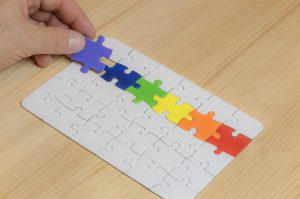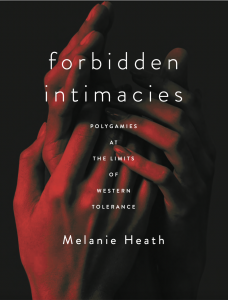Unpacking the Romantic Histories of Lesbian, Gay, and Bisexual Young Adults
Relationships of all types take work, but what we learned from interviews with lesbian, gay, and bisexual (LGB) folks was how to create relationships that allow you to bring your whole self – and shedding the expectations and limits of others along the way.
Our study, Resilience through relationship experiences: A qualitative exploration of lesbian, gay, and bisexual romantic development arose from our curiosity about how lesbian, gay and bisexual people build relationships characterized by strengths in communication, intimacy, connection, and stability in spite of the negative health outcomes and discrimination they experience. We wanted to know: What happens in between those two realities? How, even when the cards stacked against you, do you find and keep meaningful, positive relationships? What do those “successful” relationships look like for LGB folks?
A Note About the Science
To answer these questions, we analyzed relationship history interviews from 10 LGB young adults. Ten may seem like small number, but our in-depth interviews provided nearly 17 hours of contact with participants. Researchers can gain a surprising amount of insight from a small number of people if we have rich data about their experiences. In this study, interviewees detailed every sexual and relationship experiences they could recall throughout their lives. This gave us enough information to analyze how romantic development might unfold for LGB folks.
In this type of research, we do not suggest that our findings generalize to the whole population, or even to all lesbian, gay, or bisexual people. However, when we find common threads across people’s lived experiences, we venture to say that what we see in the data may be meaningful. In this case, we found three themes that helped us understand romantic development for LGB people.
Concealment
We found that some LGB folks hid their early relationships from family and friends, and they did so primarily in two ways. We called the first type “concealment through silence,” which described how LGB participants avoided conversations about their same-gender partners or sexual identities. Specifically, folks paid close attention to negative messages about homosexuality that came through their religious and cultural communities. Remaining “silent” was a response to the feeling that it was risky to be openly LGB.
We defined the second type of concealment as “overemphasizing heteronormativity.” Participants hid their sexual identities and relationships by dating different-gender partners and “acting” straight to throw others off the idea that they were LGB. One participant described acting “boy crazy” as a teen when she started to suspect that she was attracted to women.
Concealment was not universal. A few folks didn’t have to hide their early relationships or identities at all. Those who had families and communities which were accepting and open-minded were able to grow up more openly in their sexual identities.
Conformity
Another strategy that LGB participants used to navigate early relationships was to try and blend in. The two ways we saw folks conforming in their relationships was through heteronormative conformity and homonormative conformity. Heteronormative conformity happened when participants followed the scripts and expectations that are common in heterosexual relationships. For example, in addition to seeking different-gender partnerships (which ultimately felt disappointing or incomplete for lesbian and gay folks), some participants felt pressure to legitimize their same-gender relationships by having big, traditional weddings.
Homonormative conformity usually happened in LGB folks’ early same-gender partnerships, as participants tried to figure out and follow expectations in the queer community. Some participants described falling into LGB stereotypes or going through the motions of a relationship according to what they thought same-gender relationships should be like. Bisexual participants recalled feeling pressure to conform to a “monosexual” identity (lesbian, gay, or straight) in order to fit in with either queer or heterosexual standards. Regardless of the kind of conformity, it typically did not lead to the most satisfying relationship experiences.
Authenticity
Even though most of our participants had experiences with concealment and/or conformity, nearly all of them managed to build relationships which were “authentic” meaning they were grounded in participants’ needs, boundaries, and hopes for the future. The people in our study were able to shed both hetero- and homonormative expectations of what relationships should look like to evoke queer resistance, confidence, and joy. For some participants, finding authentic relationships involved some growing pains: ending limited or constrained earlier relationships, engaging in self-reflection, and shifting priorities. Authentic relationships were a process, not an end goal, and were rooted in folks’ ability to self-define and direct their own relationships.
Conclusion
Being authentic in your relationships means directing the development of the relationship in line with your goals. Regardless of a person’s identities, authenticity seems worth pursuing, even if there are challenges along the way.
Mari Tarantino (she/her) is currently a Ph.D. student at Virginia Tech studying Human Development and Family Science. Her research focuses on sexually and romantically marginalized individuals in partnerships and family contexts. Prior to starting her graduate career, Mari earned her BS in Human Development and Family Studies at the University of New Hampshire and minored in Queer Studies and Interdisciplinary Health Education. Her most recent work titled, “Queering LGB+ Women’s Sexual Scripts,” addresses how heteronormativity influences LGB+ women’s sexual partnerships and STI-pregnancy prevention efforts.
Twitter: @mari_tarantino
Tyler Jamison (she/her) is an associate professor in the Department of Human Development and Family Studies at the University of New Hampshire. Her research focuses on romantic relationship development and dissolution during adolescence and emerging adulthood. Her most recent work explores singlehood in the context of romantic life and narratives of love in long-term relationships. She writes about love and relationships for Psychology Today on her blog page Assembly Required.
Twitter: @drtylerjamison









